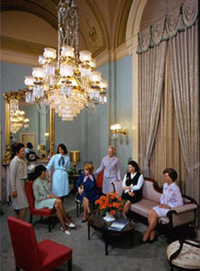Assembling, Amplifying, and Ascending
Recent Trends Among Women in Congress, 1977–2006
Introduction
 (From left) Marilyn Lloyd, Tennessee; Martha Keys, Kansas; Patricia Schroeder, Colorado; Margaret Heckler, Massachusetts; Virginia Smith, Nebraska; Helen Meyner, New Jersey; and Marjorie Holt, Maryland, in 1978 in the Congresswomen’s Suite in the Capitol—now known as the Lindy Claiborne Boggs Congressional Reading Room. Schroeder and Heckler co-chaired the Congresswomen’s Caucus, which met here in its early years.Image courtesy of the United States Capitol Historical Society
(From left) Marilyn Lloyd, Tennessee; Martha Keys, Kansas; Patricia Schroeder, Colorado; Margaret Heckler, Massachusetts; Virginia Smith, Nebraska; Helen Meyner, New Jersey; and Marjorie Holt, Maryland, in 1978 in the Congresswomen’s Suite in the Capitol—now known as the Lindy Claiborne Boggs Congressional Reading Room. Schroeder and Heckler co-chaired the Congresswomen’s Caucus, which met here in its early years.Image courtesy of the United States Capitol Historical SocietyThe fourth wave of women to enter Congress–from 1977 to 2006– was by far the largest and most diverse group. These 134 women accounted for more than half (58 percent) of all the women who have served in the history of Congress. In the House, the women formed a Congresswomen’s Caucus (later called the Congressional Caucus for Women’s Issues), to publicize legislative initiatives that were important to women. By honing their message and by cultivating political action groups to support female candidates, women became more powerful. Most important, as the numbers of Congresswomen increased and their legislative interests expanded, women accrued the seniority and influence to advance into the ranks of leadership.
Despite such achievements, women in Congress historically account for a only a small fraction—about 2 percent—of the approximately 12,000 individuals who have served in the U.S. Congress since 1789, although recent trends suggest that the presence of women in Congress will continue to increase. Based on gains principally in the House of Representatives, each of the 13 Congresses since 1981 has had a record number of women Members.
A defining moment of change was the general election of 1992 dubbed the “Year of the Woman.” The arrival of 28 new women in Congress resulted from the confluence of historic circumstances that have not recurred since. Yet, the doubling of the number of women in Congress virtually overnight had far-reaching effects on the way women were perceived in the institution. Elected to the House in 1992, Lynn Schenk of San Diego, aptly summarized the changes. “After years in the trenches, more women are finally moving up to the front lines.”1 The elections 0f 1992 inaugurated a decade of gains for women in Congress—in regard to their number and their seniority. These gains were capped by the election of Representative Nancy Pelosi as House Democratic Leader in 2002. It was the first time a woman held the top post in a major U.S. political party.
New Patterns: Familial Connections and Political Experience
During this period, the number of women elected to Congress via a familial connection—particularly widows of Congressmen—while still statistically significant, was far smaller. Of the 134 women who came to Congress during this period, just 12 (9 percent) were widows who succeeded their late husbands. Three women directly succeeded their fathers: Representatives Susan Molinari of New York, and Lucille Roybal-Allard of California, and Senator Lisa Murkowski of Alaska. In all, 11 percent of the Congresswomen from this period arrived in Congress through a familial connection.
The elections of Jo Ann Emerson of Missouri, Lois Capps of California, and Mary Bono of California—each succeeding her late husband—to the House between January 1997 and April 1998 were portrayed by the national media as a testament to the power of the marital connection. But an important factor distinguished this trio and the modern congressional widows: their professional and political résumés were more evolved than those of their predecessors. Earlier widows in Congress, such as Mae Ella Nolan of California, Katharine Byron of Maryland, and Irene Baker of Tennessee, were to various degrees involved in their husbands’ political careers. But the widows of the late 20th century had their own careers distinct from their husbands’. Whereas earlier widows, even if they were politically savvy, tended to run for office to complete their husbands’ legislative agenda—in effect, to honor their husbands’ memory—later widows were more likely to pursue interests related to careers they established before coming to Congress. For example, in 1998, Lois Capps succeeded her late husband, Walter, a theology professor-turned politician. Having worked as a nurse and medical administrator for decades, Capps eschewed her husband’s focus on religious issues and became an advocate for health care professionals and reform within the industry. In March 2005, Doris Matsui of California won a special election to succeed her late husband, Robert, head of the Democratic Party’s congressional campaign committee, after years as a White House staffer in the William J. Clinton administration.
Since many present-day congressional marriages unite partners with impressive political résumés, the influence of the widow’s—or perhaps the widower’s— mandate will likely persist.2 But while personal tragedy and matrimonial connections will undoubtedly continue to bring women into Congress, candidates will be judged less on familial ties than on prior political experience and professional accomplishments.
A matrimonial role reversal occurred in the U.S. Senate early in the new millennium. In the 1990s, President Bill Clinton of Arkansas and Senator Bob Dole of Kansas emerged as party leaders and faced off against each other in the 1996 presidential election. By 2001, both had retired from politics. Their departure marked a moment of arrival for their wives, Hillary Rodham Clinton of New York and Elizabeth Hanford Dole of North Carolina, who had subordinated their own political aspirations to further their husbands’ careers. In November 2000, Hillary Clinton won election as New York’s first woman Senator, becoming the first First Lady to hold political office. Elizabeth Dole, who had served as Secretary of Transportation and Secretary of Labor, contended for the GOP presidential nomination in 2000 and was elected to the Senate two years later, becoming the first woman to represent North Carolina in the Senate. While their husbands were guests on political talk shows on network television, Hillary Clinton and Elizabeth Dole debated policy on the Senate Floor as spokespersons for their respective parties.
While the importance of the widow’s mandate waned, the number of women elected to Congress with federal, state, and local electoral experience surged. Sixty-four women elected since 1976 (48 percent) had served in state legislatures; 12 had held state executive office positions including lieutenant governor, treasurer, and secretary of state; eight had held federal positions ranging from U.S. Ambassador to Cabinet Secretary to head of the Equal Employment Opportunity Commission; and several had been mayors of large cities. In all, nearly 60 percent had held elective or appointed office at the state or federal level.3
Moreover, the level of education of women in Congress, which had always been higher than average, exceeded that of previous generations. All but two of the women from this period (98.5 percent) had some postsecondary education, and the vast majority of these had four-year degrees. By contrast, according to the 2000 Census, just 51 percent of Americans had at least some college education. Moreover, 60 of the women (45 percent) elected to Congress during this period had held graduate degrees (among them were 23 lawyers, five doctors of philosophy, and one medical doctor), again far eclipsing the level of education in the general population (in 2000 eight percent of the U.S. population held a masters degree or a more advanced degree).4 The average age at which women were first elected or appointed to Congress between 1977 and 2006 dropped nearly two years from that of the third generation, to 48.4 years.5 The youngest woman elected to Congress in this period was Susan Molinari of New York, at age 31 years, 9 months. The oldest woman to enter Congress during this period was Jocelyn Burdick of North Dakota–a 70-year-old widow appointed to the Senate to succeed her late husband, Quentin Burdick, for the brief remainder of his term.
A significant number of the women who were elected had young families and thus were required to balance their careers with their family life. The structure of the modern congressional workweek, the necessity of frequent trips to the district, and increasing demands on Members’ time strained family life. As in American society generally, divorce became more prevalent in Congress during the third and fourth generations of women. Many Members’ families remained behind in the district instead of moving to Washington, D.C., increasing the time families were separated. Representative Lynn Martin of Illinois became an influential House Member in the 1980s, with a seat on the powerful Budget Committee and an elective position in the GOP leadership. But family concerns competed with political responsibilities. “The first time I was in Ronald Reagan’s office, I called Caroline, my 9-year-old, and I said, ‘I have just been in with President Ronald Reagan,’” Martin recalled. Her daughter replied, “‘Are you going to be here tomorrow for the carpool?’ And I said, ‘I have just been . . .’ and she said, ‘I heard you. Are you going to be here tomorrow for the carpool?’ I mean, oh my Lord: ‘I’m deciding the fate of the Western World and you’re worrying about a carpool?’ And the answer was, ‘Yes, I am.’”6 Some Congresswomen chose not to raise a family in order to devote themselves to the rigorous demands of public office. “I think one of the reasons I’ve never married and had children is because of the guilt I would feel taking time from them,” Marcy Kaptur of Ohio said in 1992. “To me, one of the great achievements of my life has been not wounding a child. To raise children in this job? You can count on one hand the number of women in this job who have.”7 Three incumbent Congresswomen gave birth later in the decade—Utah Republican Enid Greene Waldholtz (a daughter in 1995), New York Republican Susan Molinari (a daughter in 1996), and Arkansas Democrat Blanche Lambert Lincoln (twin boys in 1996).
Footnotes
- Barry M. Horstman, “Women Poised to Make Big Political Gains,” 24 August 1992. Los Angeles Times.
- At least two husbands have attempted to directly succeed their wives in the House. In 1980, Gladys Noon Spellman of Maryland suffered a heart attack and lapsed into a coma from which she never recovered. When the House declared her seat vacant in early 1981, her husband, Reuben Spellman, entered the April 1981 Democratic primary but lost. After Patsy Mink of Hawaii died in September 2002, her husband, John Francis Mink, was one of more than 30 candidates in a special election to fill her seat for the remainder of the 107th Congress. He, too, was unsuccessful.
- Five of the aforementioned group had a combination of state legislative and state executive or federal office experience.
- Statistics based on the 2000 U.S. Census. Figures are from chart QT-P20: “Educational Attainment by Sex: 2000.” Available online at http://factfinder.census.gov.
- For information on the average age of congressional Membership, see the CQ Guide to Congress, 4th ed, p. 700 and the Congressional Research Service (CRS) Profiles of the 103rd to 109th Congresses.
- David Finkel, “Women on the Verge of a Power Breakthrough,” 10 May 1992, Washington Post Magazine: W15.
- Finkel, “Women on the Verge of a Power Breakthrough.”

